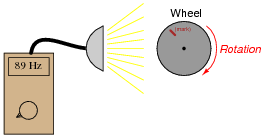Home » Worksheets
Design Project: LED stroboscope
Question 1:
A technician uses a stroboscope to "freeze" the rotation of a motorized wheel with a mark on it. With the mark appearing to stand still, the technician measures the strobe frequency at 10 Hz. Based on this measurement the technician determines the wheel's speed to be 600 RPM:

|
|
A second technician comes along and disagrees with the first. According to the second, more testing is required before it can be sure that the wheel's speed is actually 600 RPM. The first technician is perplexed: how can the speed be anything but 600 RPM, if 10 Hz is the strobe frequency where the mark is seen to ßtand still?"
The wheel may be turning at 600 RPM, or 1200 RPM, or 1800 RPM, or 2400 RPM or . . .
Follow-up question: what must the technician do with the stroboscope to be absolutely sure of the wheel's speed?
Follow-up question: what must the technician do with the stroboscope to be absolutely sure of the wheel's speed?
Notes:
Ask your students to explain why the mark would appear to stand still at so many different frequencies. Shouldn't there be only one strobe frequency where the mark appears to stand still?
Question 2:
Note that the LEDs shown in the schematic do not have voltage-dropping resistors connected in series. How is this possible, especially considering the author's prototype circuit operated at 12 volts DC (far in excess of an LED's continuous rating)?
Since the LEDs only turn on during the discharge phase of the 555's timing cycle (which is very short), greater-than-rated voltages and currents are permissible.
Notes:
This question illustrates how the advertised ratings of electronic components assume certain conditions. If one understands what these assumptions are, the component ratings may be safely ëxceeded" under special conditions. This is one such special case.
